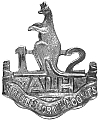
All that is known of Toddy's story
PJ's daughter, my aunt Maureen, told me that Thomas, known as "Toddy", was believed to have been killed in France during World War I while fighting with the Australian Light Horse. This turns out to be half correct. He survived the war.Thomas enlisted in the 12th Light Horse Regiment on June 4, 1915 at Liverpool, New South Wales, and stated his previous military service with the Royal Irish Lancers.
Two Australian Imperial Forces (AIF) enlistment forms survive, and differ. One says he served 7 years with the Lancers, the other that he served 18 months, then bought his discharge.
 According to official British Army records, in 1902 Thomas J. O'Connor enlisted for three years in the "Corps of Lancers of the Line". He left in 1904 after an uneventful career with the 5th (Royal Irish) Lancers by buying himself out for £18.
According to official British Army records, in 1902 Thomas J. O'Connor enlisted for three years in the "Corps of Lancers of the Line". He left in 1904 after an uneventful career with the 5th (Royal Irish) Lancers by buying himself out for £18. Clearly he was not a fan of military service but he answered the call in Australia in 1915 and with his previous service the Light Horse was the obvious choice.
He was sent overseas in September 1915 among reinforcements for the 12th Light Horse, which did not serve in France, but Thomas may have switched regiments. He certainly switched focus because he was a sapper serving with the 1st Field Squadron in Egypt when he was discharged in 1918.
The Australian War memorial archives are in error because one record has him serving with the Air Corps 1st Flying Squadron - probably a transcription error. He was also indexed in the archives as "O'Coonor", which made tracking him down rather tricky.
It is possible that he was still with the Light Horse when they made one of the world's last great cavalry charges on 31 October 1917 at Beersheba, near Gaza in Palestine, against Turkish forces.
Toddy was invalided out with a pension in April 1918 suffering from "debility" and bursitis.
On 9 September 1919 he re-enlisted in the AIF Special Services and a week later embarked at Sydney as a guard of prisoners of war on the HT Frankfurt.
The Frankfurt was a German passenger liner that had been seized by the British during World War I and used as a troopship. According to the Australian War Memorial Anzac Portal, the ship transported Australian soldiers and prisoners of war from Europe to Australia in 1919.
The "Dictionary of Sydney" records that it was also used in 1919 to deport Yugoslav internees, and a special YMCA Prisoner of War postcard dated "SS Frankfurt 24 10 1919" was posted at Suez in Egypt by a Hungarian formerly at Liverpool Camp, to a fellow internee back home in Sydney.
This must have been Toddy's only voyage while serving as a guard because at Port Said on 13 November 1919 he was listed as a casualty (no details given) and assigned to embark on the SS Königin Luise at Port Said on 30 December 1919 for return to Australia.
In February 1920 he was discharged as permanently unfit for general service. Toddy died in June 1920 and was buried in Sydney.
The Light Horse at Beersheba - the last great cavalry charge
 The charge at Beersheba on 31 October 1917 is remembered as the last great cavalry charge.
The charge at Beersheba on 31 October 1917 is remembered as the last great cavalry charge.Lt-General Harry Chauvel, the Australian commander of the Desert Mounted Corps, ordered the 4th Light Horse Brigade to make a mounted attack directly towards the town. The Brigade assembled behind rising ground 6km south-east of Beersheba with the 4th Light Horse Regiment on the right, the 12th Light Horse Regiment on the left and the 11th Light Horse Regiment in reserve.
The Australian Light Horse was to be used purely as cavalry for the first time. Although they were not equipped with cavalry sabres, the Turks who faced the long bayonets held by the Australians did not consider there was much difference between a charge by cavalry and a charge by mounted infantry. The Light Horse moved off at the trot, and almost at once quickened to a gallop. As they came over the top of the ridge and looked down the long, gentle open slope to Beersheba, they were seen by the Turkish gunners, who opened fire with shrapnel. But the pace was too fast for the gunners. After 3km Turkish machine-guns opened fire from the flank, but they were detected and silenced by British artillery. The rifle fire from the Turkish trenches was wild and high as the Light Horse approached. The front trench and the main trench were jumped and some men dismounted and then attacked the Turks with rifle and bayonet from the rear. Some galloped ahead to seize the rear trenches, while other squadrons galloped straight into Beersheba.
The 4th and 12th Light Horse casualties were 31 killed and 36 wounded; they captured over 700 men.
Source: Australian War Memorial